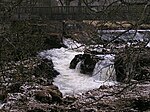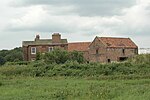Cawood Bridge
Bridges across the River Ouse, YorkshireBridges completed in 1872Bridges in North YorkshireCawoodFormer toll bridges in England ... and 4 more
Grade II listed bridgesGrade II listed buildings in North YorkshireSwing bridges in EnglandUse British English from April 2017

Cawood Bridge is a swing bridge which spans the Yorkshire River Ouse in North Yorkshire, England. Construction was authorised in 1870, with the formation of the Cawood Bridge bridge company. It was opened on 31 July 1872 to replace the ferry, and is located about halfway between Naburn and Selby. It is the only bridge from the village of Cawood that crosses the river. It is Grade II listed.
Excerpt from the Wikipedia article Cawood Bridge (License: CC BY-SA 3.0, Authors, Images).Cawood Bridge
B1222,
Geographical coordinates (GPS) Address Nearby Places Show on map
Geographical coordinates (GPS)
| Latitude | Longitude |
|---|---|
| N 53.8337 ° | E -1.1282 ° |
Address
B1222
YO8 3TJ
England, United Kingdom
Open on Google Maps










